Under Texas law, specifically Penal Code §31.03, theft is defined as unlawfully appropriating property with the intent to deprive the owner of it. That means if you take something without the owner’s effective consent — or even if you’re just found in possession of stolen property—you can be charged with theft. The severity of the charge depends on the value of the property and the circumstances involved. It can range from a Class C misdemeanor with no jail time to a first-degree felony carrying up to life in prison.
But make no mistake — a theft charge in Houston is more than just a legal issue. It can upend your life. A conviction creates a permanent criminal record that shows up on a background check, affecting employment, professional licenses, housing, and even immigration status. Theft is also considered a crime of moral turpitude, which means it reflects dishonesty or a lack of integrity — something that can follow you damaging your reputation and limiting your opportunities.
That’s why it’s so important to contact an experienced Houston theft lawyer immediately if you’ve been accused of theft. The quicker your attorney can get involved, the quicker they can begin building a strong defense, possibly even before charges are filed or your case moves forward in court.

Accused of Theft in Houston. You’re Not Alone – and You’re Not Out of Options
Being accused of theft can be overwhelming, embarrassing, and downright terrifying. You might be wondering:
- Will I go to jail?
- Will I lose my job?
- What if I didn’t know the property was stolen?
- Is there any way to keep this off my record?
The answers depend on the facts of your case — but one thing is certain: You need an experienced Houston theft lawyer who knows how to fight for you.
Mike Hanson, Senior Counsel at our Houston office, has successfully handled various theft cases — from minor shoplifting accusations to high-dollar felony thefts. As a former prosecutor, he knows how the other side thinks and what it takes to poke holes in the State’s case. He understands how to challenge the prosecution’s valuation of the property, dispute claims of ownership, and negotiate dismissals, reductions, or alternative resolutions that protect your future.
Whether you’ve been wrongfully accused or simply made a mistake, you deserve a defense that’s aggressive, strategic, and tailored to your situation.

What Constitutes Theft in Texas?
Texas defines theft broadly. Under Texas Penal Code §31.03, you appropriate property unlawfully when you take it without the owner’s effective consent. This includes shoplifting, but also covers situations many people may not immediately recognize as theft:
- Taking property without permission: Walking out of a store with unpaid merchandise, taking a bicycle left unlocked, or removing items from someone’s yard.
- Obtaining property through deception: Writing bad checks, using someone else’s credit card, or lying to obtain property under false pretenses.
- Receiving stolen property: Possessing property you know or should have known was stolen, even if you didn’t steal it yourself.
- Theft of services: Skipping out on restaurant bills, using utilities without authorization, or failing to pay for contracted services with intent to avoid payment.
The key element is the intent to deprive the owner. Prosecutors must prove you meant to permanently take the property. Borrowing something without permission and intending to return it doesn’t meet the legal definition of theft, though police often arrest first and let courts sort out intent later.
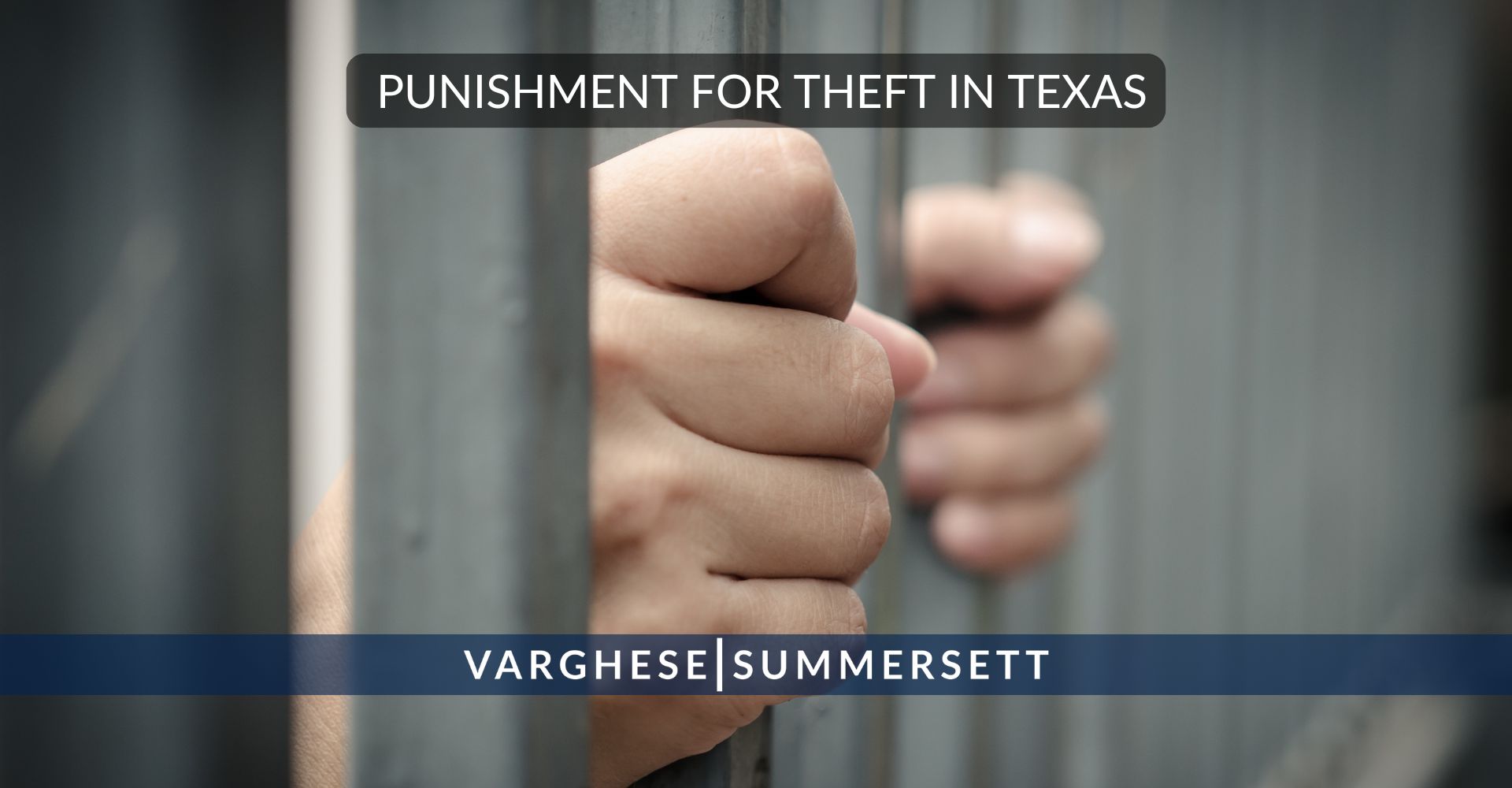
Punishment for Theft in Texas
In Texas, the severity of a theft charge largely comes down to one factor: the value of the stolen property. The higher the value, the steeper the penalties. But it’s not just about dollar amounts — your criminal history, the nature of the theft, and even who the victim was can impact how your case is charged and prosecuted.
Recent legislative changes in 2025 have made certain types of theft much more serious, especially organized retail theft and metal theft targeting critical infrastructure, which we’ll discuss further below. Here’s how theft penalties break down under current Texas law:
Class C Misdemeanor Theft
Property valued under $100 is punishable Class C misdemeanor, punishable by a fine up to $500 with no jail time. While this seems minor, it still creates a criminal record. Retailers often pursue charges aggressively even for low-value items to deter shoplifting.
Class B Misdemeanor Theft
Theft of property worth $100 to $749 is a Class B misdemeanor, carrying up to 180 days in county jail and fines up to $2,000. You also face Class B charges if you have a prior theft conviction, regardless of the current property value.
Class A Misdemeanor Theft
Property valued between $750 and $2,499 elevates theft to a Class A misdemeanor, punishable by up to one year in county jail and fines up to $4,000. Most shoplifting cases involving electronics, designer clothing, or multiple items fall into this category.
State Jail Felony Theft
When property value reaches $2,500 to $29,999, theft becomes a state jail felony carrying 180 days to two years in state jail and fines up to $10,000. Theft of firearms or livestock qualifies as a state jail felony regardless of value.
Third-Degree Felony Theft
Stealing property worth $30,000 to $149,999 results in third-degree felony charges with penalties of 2 to 10 years in prison and fines up to $10,000. This level typically involves vehicle theft, heavy equipment, or accumulated retail theft.
Second-Degree Felony Theft
Property valued between $150,000 and $299,999 carries second-degree felony charges: 2 to 20 years in prison and up to $10,000 in fines. Cases at this level often involve embezzlement, large-scale fraud, or high-value vehicle theft.
First-Degree Felony Theft
Theft of property worth $300,000 or more is a first-degree felony, punishable by 5 to 99 years or life in prison and fines up to $10,000. These prosecutions typically target organized theft rings, significant embezzlement schemes, or theft of extremely valuable property.
Table: Texas Theft Penalties
In Texas, theft penalties are primarily based on the value of the stolen property. The following table outlines how theft offenses are classified and punished under current law:
| Offense Level |
Property Value |
Penalties |
| Class C Misdemeanor |
Under $100 |
Fine up to $500; no jail time |
| Class B Misdemeanor |
$100 to $749 |
Up to 180 days in jail; up to $2,000 fine |
| Class A Misdemeanor |
$750 to $2,499 |
Up to 1 year in jail; up to $4,000 fine |
| State Jail Felony |
$2,500 to $29,999 |
180 days to 2 years in state jail; up to $10,000 fine |
| Third-Degree Felony |
$30,000 to $149,999 |
2 to 10 years in prison; up to $10,000 fine |
| Second-Degree Felony |
$150,000 to $299,999 |
2 to 20 years in prison; up to $10,000 fine |
| First-Degree Felony |
$300,000 or more |
5 to 99 years or life in prison; up to $10,000 fine |
Enhanced Penalties Under 2025 Laws
Texas legislators passed significant theft law updates effective September 1, 2025. Understanding these changes is critical because they dramatically increase penalties for specific theft types:
Organized Retail Theft (Senate Bill 1300)
SB 1300 targets retail theft rings operating across multiple locations. If prosecutors prove you participated in organized retail theft— meaning coordinated theft with others or repeated thefts as part of a scheme — they can aggregate the value of all stolen items across multiple incidents and locations. This aggregation often elevates misdemeanor shoplifting to felony charges.
The law expands liability to participants in theft rings, including lookouts, drivers, and people who fence stolen goods. Even if you didn’t personally steal items, involvement in the organization exposes you to the same charges as the person who walked out of the store.
Metal Theft Enhancements
Stealing copper, brass, or other metals from critical infrastructure facilities now carries elevated penalties under amendments to §31.03 enacted September 24, 2025. Critical infrastructure includes utility facilities, communication networks, transportation systems, and energy installations. These cases often result in state jail felony or higher charges regardless of metal value due to the danger posed to public infrastructure.
Enhancement for Vulnerable Victims
Texas increases penalties when theft targets elderly individuals (age 65 or older), disabled persons, or government entities. A theft that would normally be a misdemeanor becomes a felony when committed against these protected classes. Charges increase by one degree across all levels.
Public Servant or Contractor Status
If you’re a public servant, Medicare provider, or contractor who steals property related to your position, penalties increase by one degree. A state employee embezzling $5,000 faces third-degree felony charges rather than state jail felony charges applicable to other defendants.

How Stolen Property Value Is Determined
Property valuation determines your entire case classification. Section 31.08 amendments effective June 10, 2025, clarified how courts calculate stolen property value:
- Fair market value: Courts use the price a willing buyer would pay a willing seller for the property in its condition at the time of theft. This isn’t necessarily the retail price — used items are valued at their depreciated worth.
- Replacement cost: If market value is difficult to determine, courts may use the reasonable cost to replace the property with equivalent items.
- Aggregation rules: Prosecutors can combine the value of multiple items stolen in a single theft. They can also aggregate thefts from the same victim over time or thefts from multiple victims as part of a single scheme or continuing course of conduct.
Defense attorneys challenge valuations constantly. Retailers often claim retail prices for items they purchased wholesale. Digital property, services, and unique items create valuation disputes.
Houston Theft Lawyer Mike Hanson is known for his meticulous approach to criminal defense. He scrutinizes every valuation claim, demanding proof of actual value and objecting to inflated assessments that push cases into higher charge categories.

Common Theft Scenarios in Houston
Theft charges in Houston don’t usually stem from heists or criminal masterminds — they often arise from everyday situations. Whether it’s a misunderstanding at the store, a workplace investigation, or a dispute over property use, these cases can have serious legal consequences.
At Varghese Summersett, we’ve handled every type of theft case and know how local law enforcement, prosecutors, and major retailers approach these situations. Here are some of the most common theft scenarios we see in the Houston area — and why having the right defense strategy from the start makes all the difference.
Retail Theft and Shoplifting
Houston stores employ sophisticated loss prevention systems, including facial recognition, AI-powered surveillance, and organized retail crime databases. Major retailers share information about suspected shoplifters across locations. Loss prevention officers often wait until you leave the store to stop you, even if they observed the theft inside.
Retailers pursue criminal charges for thefts of any amount. The “they won’t prosecute if it’s under $X” myth is false. Harris County prosecutors file charges on sub-$100 thefts regularly, particularly when stores have clear video evidence.
Employee Theft and Embezzlement
Theft by employees accounts for significant criminal cases in Houston. These cases range from pocketing cash to elaborate accounting fraud. Employers typically conduct internal investigations before involving police, gathering extensive documentation before filing charges.
Employee theft cases often involve voluntary statements made during workplace investigations. Employees don’t realize these statements will be turned over to police and used in criminal prosecutions. Never provide written statements or participate in workplace “interviews” about missing property without consulting an attorney first.
Theft by Check
Writing checks without sufficient funds constitutes theft under Texas law if you intended to deprive the payee of the property or service. Prosecutors often file charges when checks bounce and the writer doesn’t make payment within 10 days of receiving notice.
Many theft by check cases involve misunderstandings about account balances, bank errors, or payments made before charges were filed. These cases are highly defensible when you can show lack of intent to defraud.

Defenses to Houston Theft Charges
When you’re facing theft allegations in one of the toughest legal environments in Texas, you need a Houston theft lawyer who understands how to dismantle the prosecution’s case from every angle. Texas law recognizes certain statutory defenses to theft, but in practice, the most powerful defense strategies come from a deep understanding of the facts, the evidence, and how prosecutors build their narrative. No two cases are identical — and that means opportunities for challenging the State’s evidence are often unique to your situation.
A skilled Houston theft lawyer knows how to use those opportunities to your advantage — whether that means disputing intent, questioning ownership, or suppressing illegally obtained evidence. Below are some of the most effective defenses commonly used to fight theft charges in Harris County and across Texas.
Lack of Intent to Permanently Deprive
Theft requires intent to permanently deprive the owner of property. If you intended to return the property or reasonably believed you had permission to take it temporarily, you lack the mental state required for theft. This defense appears frequently in cases involving friends, family members, or workplace property.
Mistake of Fact
If you genuinely believed the property belonged to you or you had permission to take it, you haven’t committed theft. Mistake of fact is a complete defense when your belief was reasonable. Cases involving similar-looking items, confusion about ownership, or miscommunication about permission often turn on this defense.
Ownership or Consent Disputes
Theft requires proof that property belonged to someone else and that you lacked effective consent to take it. When ownership is disputed — property acquired during a relationship, items claimed by multiple parties, or contested business assets — prosecutors struggle to prove you stole property that may have been partially yours.
Consent defenses challenge whether the owner’s permission was truly absent. If the owner gave you access to property, passwords, or facilities, prosecutors must prove your access exceeded the scope of permission given.
Insufficient Valuation Evidence
Prosecutors bear the burden of proving property value beyond a reasonable doubt. They must present credible evidence establishing the value that determines your charge level. Defense attorneys challenge valuations by demanding receipts, purchase records, or expert appraisals. When prosecutors can’t prove value, courts may reduce charges to the next lower category or dismiss them entirely.
Challenging Aggregation
When prosecutors aggregate multiple thefts to reach felony thresholds, defense attorneys challenge whether the incidents constitute a single scheme or continuing course of conduct. If thefts are separate, unrelated incidents, prosecutors may not be able to combine their values.
Illegal Search and Seizure
Physical evidence — stolen property, digital records, surveillance footage — must be obtained legally. If police searched your vehicle, home, or phone without a warrant or valid exception, that evidence may be suppressed under the Fourth Amendment and Texas Code of Criminal Procedure Article 38.23.
Many retail theft cases involve loss prevention officers detaining suspects and searching their bags or persons. These private security personnel have limited authority. If they exceeded their legal authority or coerced you into consenting to searches, that evidence may be inadmissible.
Every theft case is different — and so is every defense. What matters most is having a Houston theft lawyer who knows how to analyze the evidence, identify weaknesses in the prosecution’s case, and present your story in a way that resonates with judges and juries. From questioning intent to challenging ownership and valuation, the right defense strategy can mean the difference between a conviction and a dismissal.
If you’re accused of theft in Houston or anywhere in Harris County, don’t wait for your case to build itself. Work with a Houston theft lawyer who has the experience, insight, and determination to protect your reputation, your freedom, and your future.
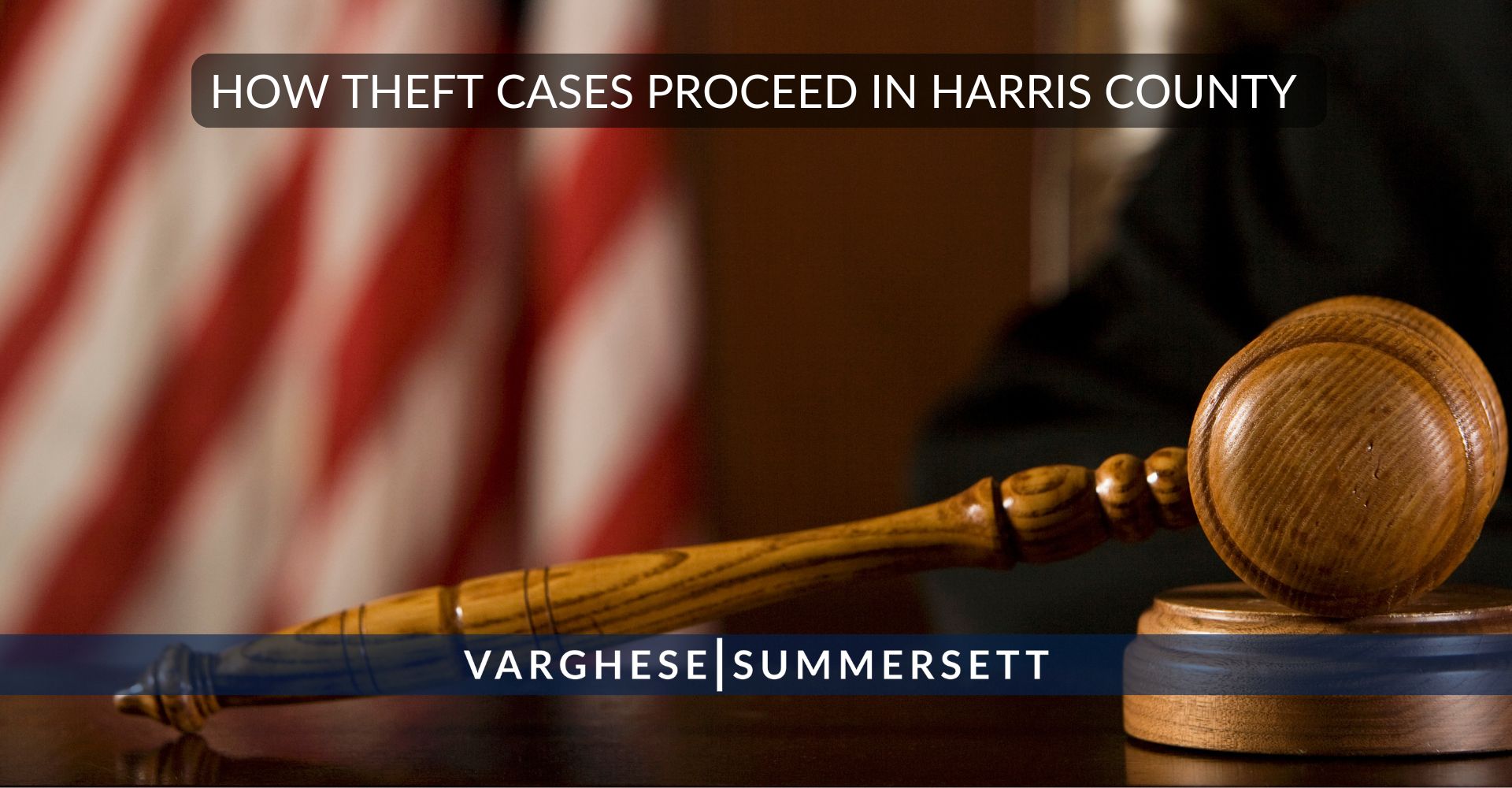
How Theft Cases Proceed in Harris County
Most theft cases begin with police reports filed by retailers, employers, or individuals. Officers investigate, review evidence, and forward cases to the Harris County District Attorney’s Office or County Attorney’s Office, depending on charge level.
Prosecutors review cases and decide whether to accept charges. They consider evidence quality, witness cooperation, property value documentation, and your criminal history. Many cases get rejected at this stage due to insufficient evidence, valuation problems, or credibility issues.
If prosecutors accept charges, you receive a court date. Misdemeanor theft cases go to county criminal courts. Felony cases proceed to district courts after grand jury indictment.
The Harris County District Attorneys Office is particularly focused on organized retail theft enforcement following the passage of Senate Bill 1300. Harris County prosecutors are less likely to dismiss retail theft cases than they were five years ago, though first-time offenders still have access to diversion programs.
Federal Theft Charges
Some theft cases trigger federal jurisdiction. Federal prosecutors become involved when theft includes:
- Interstate commerce (18 U.S.C. §2314): Transporting stolen goods worth $5,000 or more across state lines becomes a federal offense carrying up to 10 years in federal prison.
- Federal property or contracts: Stealing from defense contracts, government facilities, or federally funded programs triggers federal jurisdiction.
- Wire or mail fraud: Theft schemes involving interstate communications, wire transfers, or mail systems often result in federal charges under 18 U.S.C. §1343 and §1341.
Federal cases proceed differently from state cases. Federal sentencing guidelines often result in harsher penalties than comparable state charges. If you’re facing federal theft charges, you need an attorney experienced in federal court procedures.

Alternative Resolutions
Pretrial Diversion for First-Time Theft Offenders
Harris County and Fort Bend County offer pretrial diversion programs for eligible first-time offenders. These programs typically require:
- Completion of theft education classes
- Community service hours
- Restitution to the victim
- Compliance with court conditions for 90 days to one year
Successful completion results in dismissal of charges. You avoid conviction and maintain eligibility for record expunction.
Not every case qualifies for diversion. Prosecutors deny diversion for high-value thefts, defendants with prior criminal history, or cases involving aggravating circumstances. Even when offered, diversion requires you to accept responsibility. If you have strong defenses and viable chances of acquittal, accepting diversion may not be your best option.
Deferred Adjudication and Probation
Deferred adjudication allows you to plead guilty or no contest while the court defers finding you guilty and places you on community supervision. If you successfully complete probation, the case is dismissed, and you’re never convicted.
However, deferred adjudication has significant consequences. The arrest and deferred adjudication remain on your record. While you can later seek an order of nondisclosure to seal the record from public view, the case still appears in certain background checks and counts as a prior conviction if you’re arrested for theft again.
Straight probation involves a finding of guilt followed by probation instead of jail time. You’re convicted, but you avoid incarceration if you comply with probation terms. Violations result in jail or prison time for the underlying offense.
Restitution in Theft Cases
Courts routinely order restitution — repaying the victim for their loss — as part of plea agreements or sentencing. Inability to pay restitution creates serious problems. Courts can extend probation, convert probation to jail time, or find you in violation, leading to incarceration.
Defense attorneys negotiate restitution terms during plea discussions. Payment plans, community service alternatives, and reduced restitution amounts may be available depending on your financial circumstances and the victim’s willingness to negotiate.
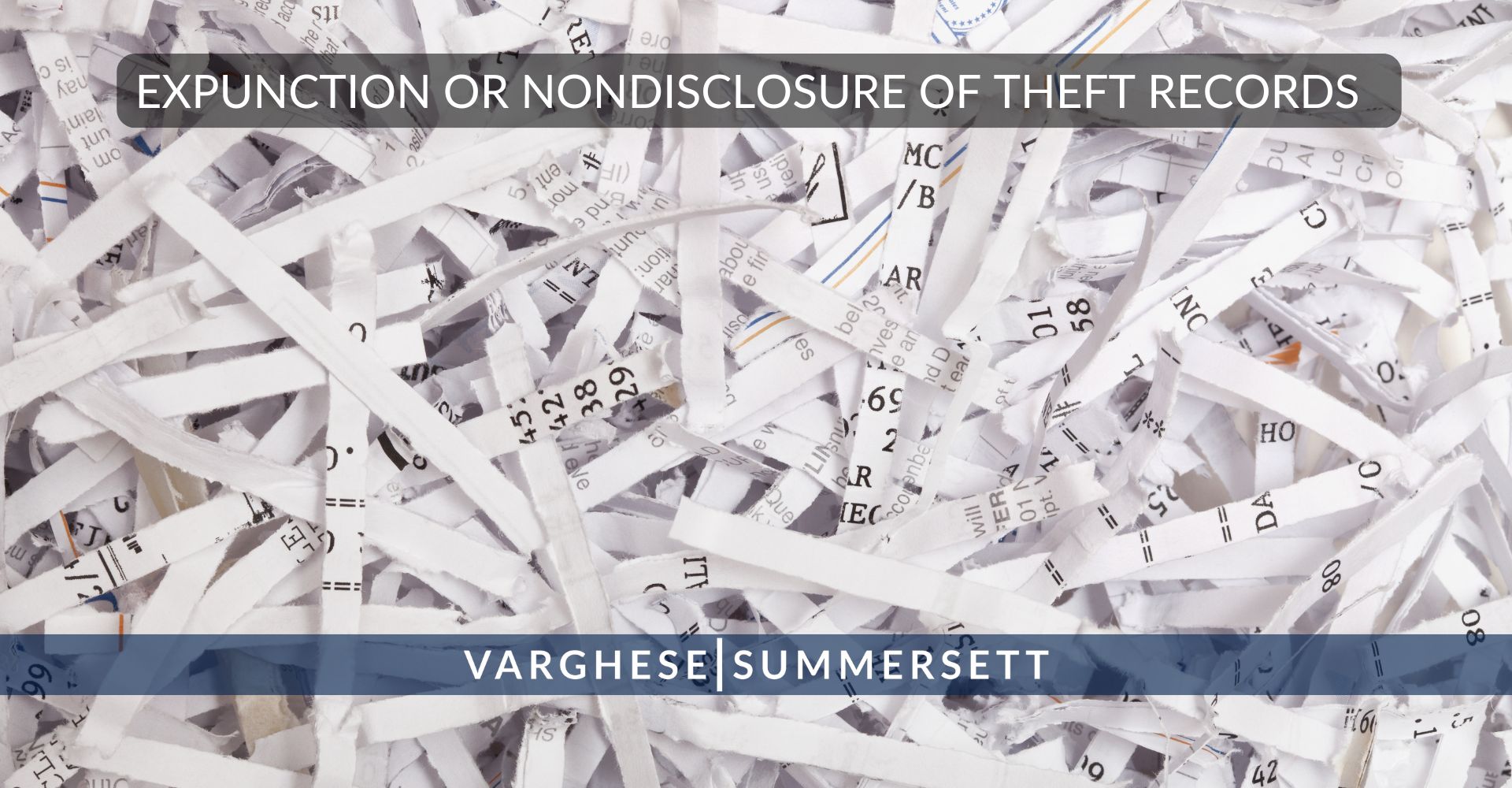
Expunction and Nondisclosure of Theft Records
If your theft case is dismissed, you’re acquitted at trial, or charges are never filed, you can petition for expunction under Texas Code of Criminal Procedure Chapter 55. Expunction completely erases the arrest record as if it never occurred.
If you receive deferred adjudication for a theft misdemeanor, you may qualify for an order of nondisclosure after completing probation. Nondisclosure seals your record from public view, though law enforcement and certain licensing agencies retain access.
Felony theft convictions cannot be sealed or expunged in Texas. This permanent record underscores why fighting charges aggressively from the start is essential.
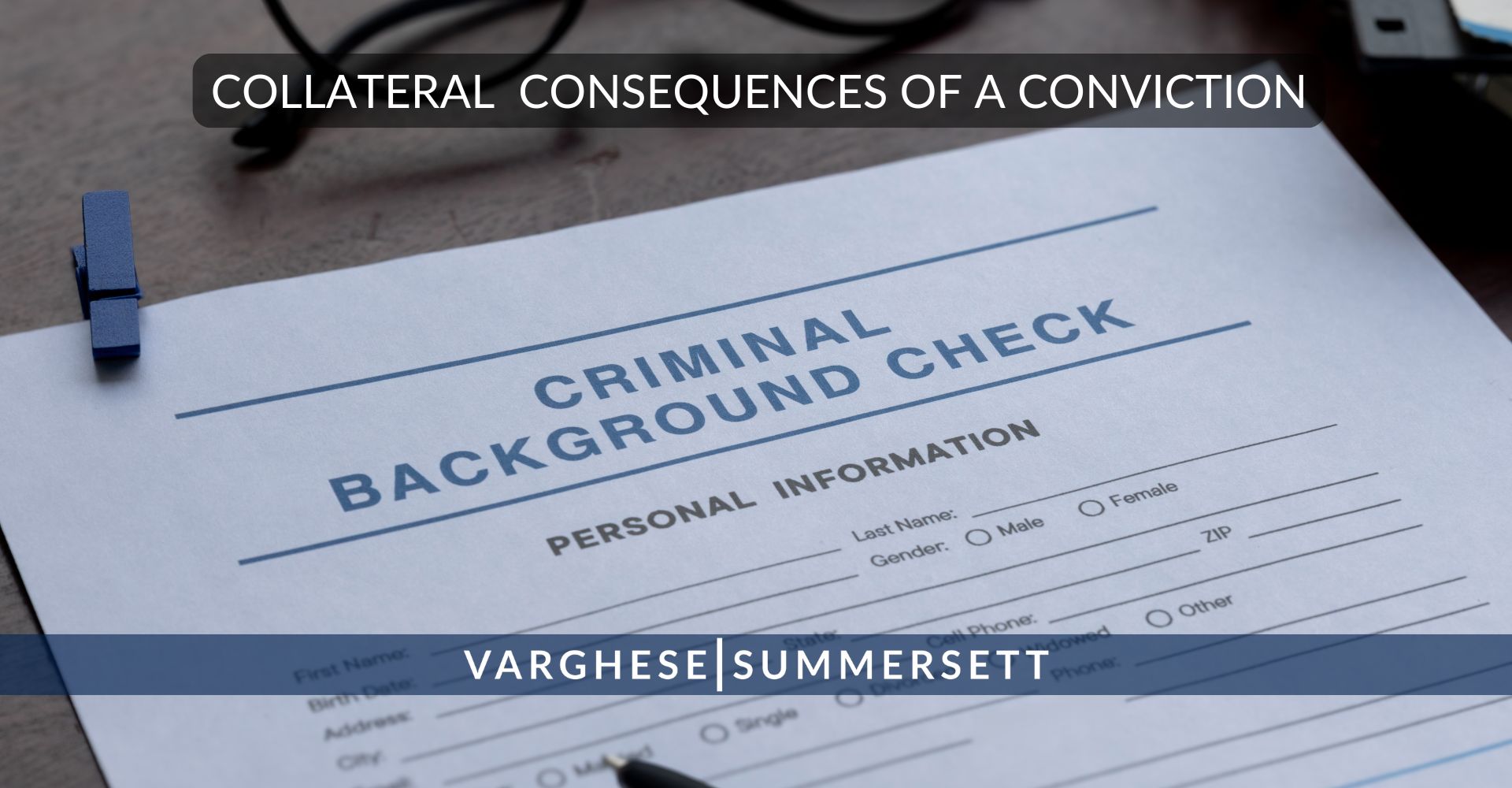
Collateral Consequences of Theft Convictions
Impact on Employment
Theft convictions appear on criminal background checks and create significant employment barriers. Employers view theft as a crime of moral turpitude — an offense involving dishonesty or fraud. Many industries automatically disqualify applicants with theft convictions:
- Financial services and banking
- Healthcare and pharmaceutical industries
- Retail and cash-handling positions
- Government employment
- Positions requiring security clearances
- Professional licenses (nursing, real estate, insurance)
Even when employers don’t automatically disqualify theft convictions, you must disclose them on applications and explain them in interviews. This creates obstacles that simply don’t exist with other offenses.
Impact on Professional Licensing
Texas licensing boards take theft convictions seriously. Nurses, teachers, real estate agents, insurance agents, attorneys, accountants, and other licensed professionals face license suspension, revocation, or denial based on theft convictions.
Licensing boards consider theft a direct reflection of character and fitness to practice. Even deferred adjudication can trigger disciplinary proceedings because boards focus on the underlying conduct, not just convictions.
If you hold or are pursuing a professional license, fighting theft charges becomes even more critical. Mike Hanson works closely with clients to understand licensing implications and structure defense strategies that protect both your freedom and your career.
Impact on Immigration Status
Non-citizens face severe immigration consequences for theft convictions. Theft offenses typically qualify as crimes involving moral turpitude under federal immigration law. A single conviction for a crime involving moral turpitude committed within five years of admission to the United States can result in deportation.
Multiple theft convictions, or theft with a sentence exceeding one year, create additional grounds for removal. Even lawful permanent residents risk losing their status.
Non-citizens must consult with an immigration attorney before accepting any plea agreement. Mike Hanson coordinates with immigration counsel to structure outcomes that minimize or eliminate immigration consequences when possible.

What to Do If You’re Arrested for Theft
Your actions immediately after arrest significantly impact your case:
Remain silent. Do not explain yourself to police. You cannot talk your way out of arrest. Everything you say will be used against you in court. Politely decline to answer questions and request an attorney.
Do not consent to searches. Police and loss prevention officers may ask to search your bag, vehicle, or phone. Refuse consent. Make them obtain a warrant. Many cases are won on suppression motions when searches exceed legal authority.
Do not sign statements. Retailers and employers often ask suspects to sign written statements admitting to theft or promising to pay restitution. These statements become prosecution evidence. Never sign anything without attorney review.
Document your side. Write down exactly what happened while it’s fresh in your memory. Identify potential witnesses. Gather receipts, text messages, or other evidence supporting your account.
Contact an attorney immediately. The sooner your attorney gets involved, the more opportunities exist to obtain favorable outcomes.
Why You Need a Houston Theft Defense Attorney
Theft cases seem straightforward — prosecutors have video, witness statements, and physical evidence. But significant defenses exist in almost every case. Property valuations are inflated. Intent is mischaracterized. Search and seizure violations occur. Ownership is disputed.
Without an attorney, you won’t recognize these defenses. You’ll accept plea offers that are worse than necessary, agree to valuations that overstate property worth, and plead guilty when dismissal was possible.
Harris County prosecutors handle thousands of theft cases annually. They have standard offers and limited time to evaluate individual cases. Defense attorneys with Houston experience know which prosecutors are reasonable, which judges are receptive to defense arguments, and how to position cases for optimal outcomes.
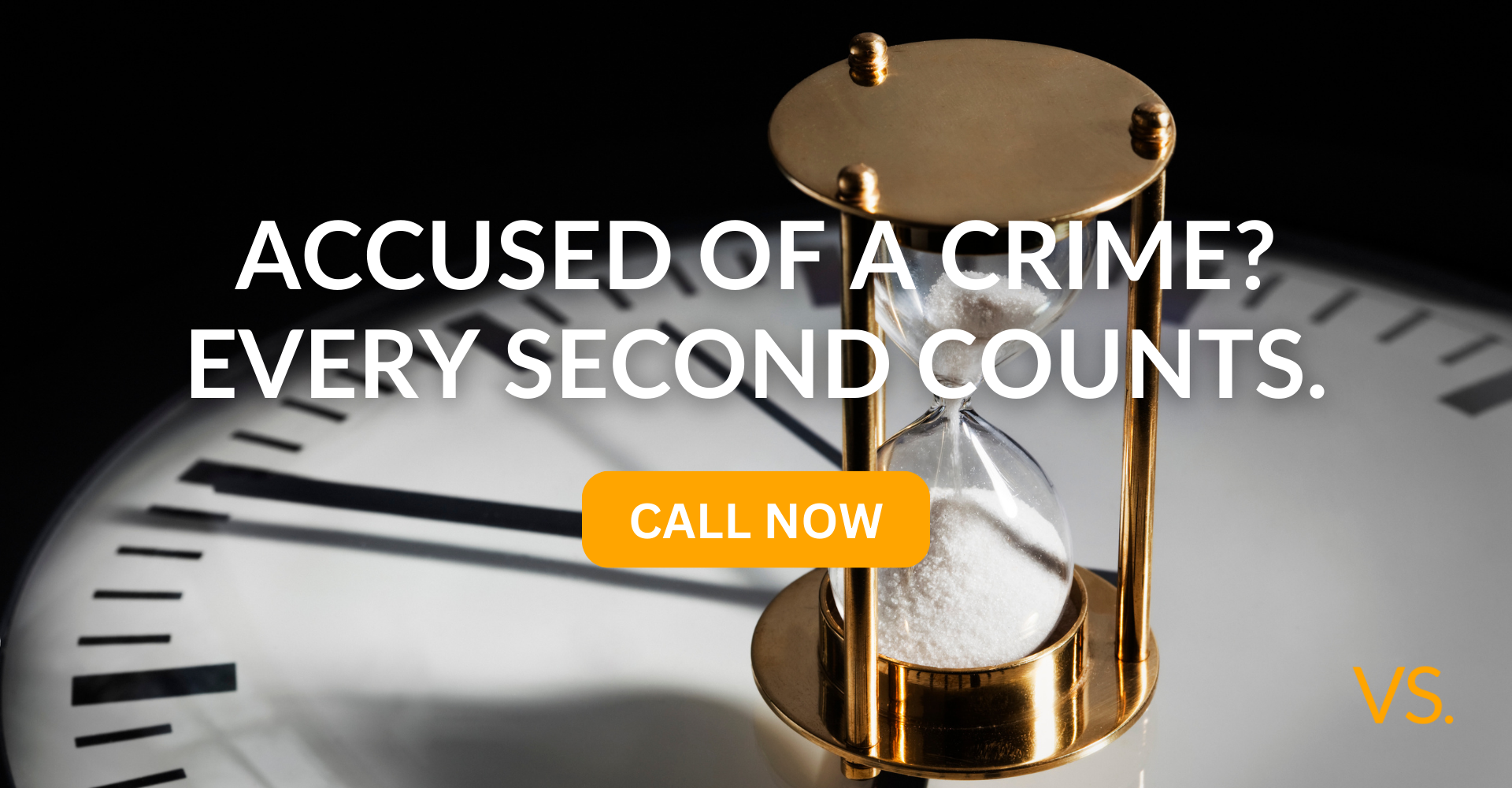
When to Contact a Houston Theft Lawyer
Contact a criminal defense attorney immediately after arrest or if you learn you’re under investigation for theft. Early attorney involvement creates opportunities to shape the outcome before charges are filed.
Early representation allows your attorney to:
- Communicate with prosecutors before charging decisions are made
- Gather exculpatory evidence while it’s still available
- Interview witnesses before memories fade or stories change
- Preserve surveillance footage and digital evidence
- Challenge property valuations before they become entrenched
- Negotiate restitution arrangements that lead to dismissal
Waiting until your court date limits your attorney’s options. Evidence disappears, witnesses become unavailable, and prosecutors have already invested time building their case.
Why Choose Varghese Summersett for Your Houston Theft Case
Varghese Summersett has successfully defended theft cases ranging from Class C misdemeanor shoplifting to first-degree felony organized theft charges. Our approach combines meticulous case preparation with aggressive negotiation to achieve the best possible outcome for each client.
Mike Hanson leads our Houston office and brings extensive experience in Harris County courts. He understands how prosecutors evaluate theft cases, how to challenge property valuations, and how to identify weaknesses in the State’s evidence that lead to dismissals or favorable plea agreements.
We’ve obtained dismissals in cases where valuations couldn’t be proven, negotiated pretrial diversion for first-time offenders, and structured plea agreements that avoided jail time while protecting our clients’ employment and licensing opportunities.
Protect Your Future After a Theft Charge
A theft charge threatens your freedom, your record, your career, and your future opportunities. You don’t have to face these charges alone or accept the prosecution’s version of events.
Call Varghese Summersett today at (281) 805-2220 or contact us online to schedule a confidential consultation with Houston Theft Attorney Mike Hanson. We’ll review the facts of your case, explain your options, and outline a defense strategy tailored to your specific circumstances. The sooner you act, the quicker we can get to work on your case.
